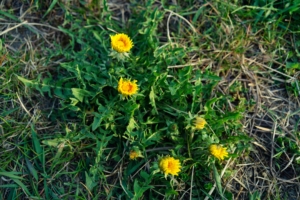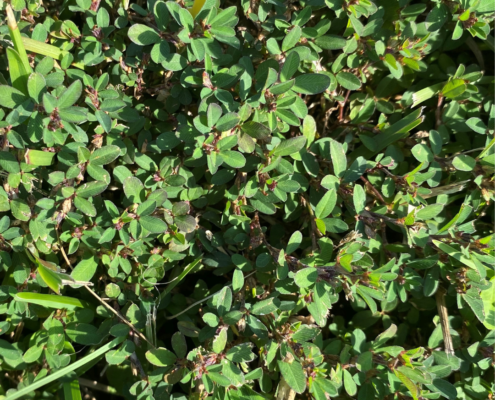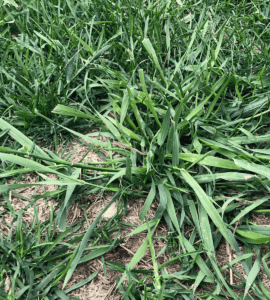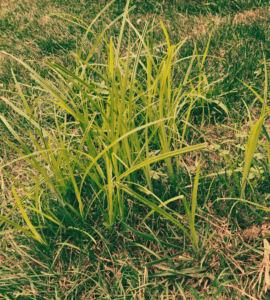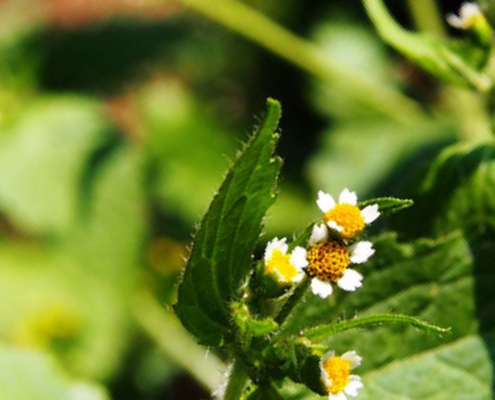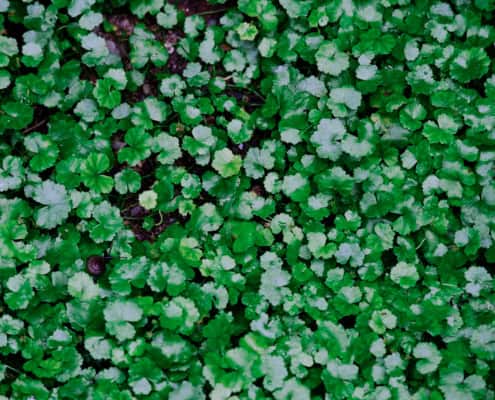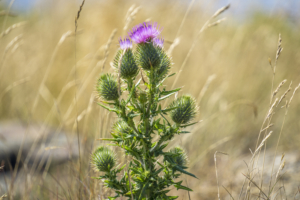12 Most Common Types of Grass Weeds in the US – With Pictures
My grandma always said, “Without hard work, nothing grows but weeds.” This wisdom rings especially true for homeowners with beautiful gardens. I was just 7 years old when she first shared this saying with me.
Anyhow, for the record, weeds are essentially plants that sprout where they’re not wanted. Certain species, known for their invasive tendencies, can disrupt the aesthetic of your yard and take over the plants you’ve carefully grown in your garden.
We have put together this guide to help you spot the 12 most common types of weeds in the US with the help of some photos. Also, we will provide you with natural tips on how to get rid of weeds.
But hear me out garden enthusiasts: Don’t let frustration win. This guide is designed to help you maintain a beautiful and healthy lawn and garden exactly the way you want it.
1. Dandelions
The famous Dandelions, easy to recognize as those bright yellow plants that turn into fluffy seed heads, are often seen as a nuisance in lawns.
What Are Dandelions?
They’re a type of perennial grass weed, known for living and growing over multiple years. Dandelions can grow just about anywhere, making them a tough opponent for gardeners.
Size and Appearance
These plants are small, around 12 inches tall and 6-16 inches wide, with yellow flowers and white fluffy seeds. They prefer sunny spots and fertile soil but can grow in a wide range of conditions.
Where Do Dandelions Grow?
You’ll find them in lawns, gardens, and on the roadside. Their seeds spread easily with the wind, helping them to pop up everywhere.
How to Control Dandelions
- Mow regularly: It helps keep them from spreading but won’t get rid of them completely.
- Pull them by hand: Make sure to get the whole root so they don’t grow back.
- Use herbicides: Use only natural formulas such as vinegar-salt solutions or something similar.
While Dandelions might bother some homeowners, they’re quite beneficial for the environment, as they provide food for bees and can be eaten by humans too.
2. Chickweed
Chickweed, a small, leafy plant often unnoticed by many, is a common “guest” in gardens and lawns across various climates.
What is Chickweed?
Chickweed (Stellaria media) is a broadleaf annual grass weed, which means it completes its life cycle in one year, usually from spring to fall. This weed thrives in cooler temperatures, and can often be found adding a green carpet to gardens when other plants are dormant.
Size and Appearance
Chickweed is petite, with its height generally reaching only 2 to 8 inches and 12 inches wide. Its most distinctive features include small, oval, pointed leaves arranged in pairs opposite each other along the stem. The plant boasts tiny, white, star-shaped flowers that bloom from late winter through spring.
Where Does Chickweed Grow?
This adaptable plant prefers moist, fertile soil but isn’t too picky, making its home in gardens, lawns, and even between sidewalk cracks. Chickweed loves shaded or partially shaded areas, often flourishing where other plants might struggle.
How to Control Chickweed
- Pull it out: Its shallow roots make it easy to remove by hand, especially in moist soil.
- Use mulch: A thick layer of mulch can prevent chickweed seeds from sprouting.
- Water wisely: Water plants deeply but less often to discourage chickweed, which likes moist surfaces.
- Consider herbicides: For severe cases, a broadleaf weed herbicide can help. Always follow directions closely.
3. Clover
Clover is known for its ability to sprout almost anywhere, this plant has both useful and potentially invasive traits.
What is Clover?
Clover, scientifically known as Trifolium, is a Broadleaf perennial grass weed, meaning it lives for more than two years, spreading and growing season after season.
Size and Appearance
Generally, clover plants range from 8-10 inches tall, and 12 inches wide but can spread across a wide area due to their creeping growth habit, often used as one of the most popular grass alternatives. Clover is easily identifiable by its small, round, three (sometimes four) leaflets and white or pink globular flowers that bloom from spring to fall.
Where Does Clover Grow?
Clover can grow just about anywhere but prefers a sunny or lightly shaded place with well-drained soil. It’s often seen in gardens, lawns, field edges, and even roadsides.
How to Control Clover
While clover is seen by some as an attractive ground cover and is beneficial to pollinators and soil health, it can become invasive if left unchecked. Here are some effective tips for controlling it:
- Maintain Your Lawn: Keep your lawn healthy to stop clover. Regularly feed, mow, and water your grass.
- Hand-Pull Clover: For small clover patches, hand-pull the weed. Ensure you remove the whole root.
- Use Herbicides: For larger infestations, consider using an iron-based herbicide to get rid of clover growing in lawns. Follow all instructions carefully.
4. Common Lespedeza
Common Lespedeza (Lespedeza striata) is not your typical grassy weed but a summer annual legume, mostly found throughout the southeastern regions of the United States.
What is Common Lespedeza?
Common Lespedeza, often mistaken for a grassy weed due to its presence in turf, is known for being tough, low-growing, and the ability to thrive in poor soil conditions.
Size and Appearance
Common Lespedeza grows close to the ground, spreading out to about 15-18 inches wide. The leaves are small, oblong, and a bit fuzzy, and they come in groups of three. Look out for pink to purple flowers blooming from late spring to early fall.
Where Does Common Lespedeza Grow?
This plant refers warm climates and is often found in the southeastern U.S. It can pop up in nutrient-poor turf, compacted soils, and disturbed areas like roadside verges.
How to Control Common Lespedeza
Here are some straightforward tips for managing this persistent weed:
- Healthy Lawn: Keep your lawn well-fed, adequately watered, and mowed at the right height to outcompete lespedeza.
- Use Herbicides: Apply post-emergent herbicides when the weed is actively growing, and consider pre-emergent herbicides in late winter to prevent seeds from sprouting.
- Pull It Out: For small infestations, pulling the weed out by hand after a rain can work. Make sure to get as much of the root as possible.
- Mindful Mowing: Avoid spreading seeds with your lawnmower. If you mow an area with lespedeza, clean your mower afterward.
5. Crabgrass
Crabgrass is one of the most common and tenacious weeds you’ll find in gardens and lawns.
What is Crabgrass?
Botanically, it’s known as ‘Digitaria’ and part of the grass family. Crabgrass is an annual weed, which means it completes its lifecycle in one growing season and then dies off, but not before making sure to drop plenty of seeds for the next generation.
Size and Appearance
Crabgrass spreads from the center, covering the ground with a thick mat and grows 12-18 inches wide. It looks like crab legs due to its coarse, light green leaves. The plant grows flat on the ground, with shoots and leaves spreading from the center. It flowers and seeds on spikes, turning purple-brown by late summer.
Where Does Crabgrass Grow?
Unfortunately for you homeowner, Crabgrass isn’t picky and grows where other grasses struggle, like lawns, vacant lots, and gardens. It favors the sun, warmth, and thrives especially in compacted soil with poor drainage.
How to Control Crabgrass
Controlling crabgrass is quite challenging but doable with these tactics:
- Healthy Lawn: Maintain a dense, healthy turf to outcompete crabgrass. Aerate, fertilize, and water appropriately.
- Pre-Emergent Herbicides: Apply these before crabgrass seeds sprout in early spring to stop them from germinating.
- Proper Mowing: Cut grass to 2.5-3 inches to shade the ground and prevent crabgrass growth.
- Pull Weeds: For small outbreaks, manually remove crabgrass, ensuring to remove the roots.
- Post-Emergent Herbicides: Use these when crabgrass has established – follow the instructions carefully.
6. Nutsedge
Nutsedge stands out as a particularly stubborn adversary for garden enthusiasts. This persistent weed, commonly referred to as “nutgrass,” despite not being a true grass, can cause some frustration for many due to its rapid growth and resilience.
What is Nutsedge?
Nutsedge is a perennial weed belonging to the genus Cyperus. It is known for its V-shaped stems, glossy leaves, and a robust underground network. These underground networks store energy that allows the plant to regrow, even after above-ground parts have been removed. So, make sure to dig deep for those roots.
Size and Appearance
Nutsedge usually grows to about 8-30 inches tall, and is easily recognizable due to its color which has a bright green or yellow-green foliage. Also, the foliage looks more like the blades of coarse grass.
Where Does Nutsedge Grow?
Flourishes in both well-watered and poorly-drained soils. It thrives in warm, moist conditions but can adapt to multiple climates. It is often encountered in lawns, gardens, agricultural fields, and water-accumulating areas.
How to Control Nutsedge
Controlling nutsedge can be tough due to its resilience and persistent tubers, so take it easy.
- Maintain a Healthy Lawn: A dense, healthy lawn can deter nutsedge. Regular mowing, proper fertilization, and good drainage are key.
- Hand-Pull Young Plants: For small infestations, manually remove young nutsedge, ensuring you get as much of the root system as possible to prevent regrowth.
- Apply Suitable Herbicides: Use selective herbicides designed for nutsedge. Follow the manufacturer’s instructions carefully, paying attention to timing for effectiveness.
- Minimize Moisture: Nutsedge loves moisture, so eliminate standing water and improve soil drainage to make your garden less appealing.
- Be Persistent: Controlling nutsedge demands patience and ongoing effort. You might need multiple treatments and consistent monitoring to effectively manage this weed.
7. Quickweed
Quickweed, or Galinsoga parviflora, native to South and Central America, lives up to its name as a fast-growing, resilient garden invader and worse garden enthusiast nightmare.
What is Quickweed?
Quickweed, often called Gallant Soldier or Guasca, is a fast-growing weed in the Asteraceae family. Although considered invasive, it’s used for food and medicine in some cultures. It completes its growth cycle in just five weeks, making it a tough challenge for gardeners and farmers.
Size and Appearance
Typically reaches a height of 1 to 2 feet, with small, lance-shaped leaves and branching stems that can give it a bushy appearance. Its flowers are small, white, and daisy-like, often going unnoticed until the plant has fully invaded a space.
How to Control Quickweed
Tips to control Quickweed:
- Manual Removal: Regularly pull out plants before they flower, ensuring you remove entire roots.
- Mulching: A thick mulch layer can block sunlight, stifling Quickweed and improving soil health.
- Cover Crops: These can compete with Quickweed for light and nutrients, reducing its growth.
- Herbicide Use: In severe cases, selective herbicides might be necessary, though they’re a last resort due to environmental impact.
- Maintain Garden Health: Dense, healthy gardens resist quickweed invasion. Enhanced resilience can come from overseeding, proper fertilizing, and regular pruning.
8. Creeping Charlie
Creeping Charlie, is a common but often unwelcome plant for some gardeners. Despite its green, sprawling appeal, it’s a resilient weed that can invade lawns and gardens.
What is Creeping Charlie?
Creeping Charlie, or Glechoma hederacea, is a fast-spreading, evergreen weed from the mint family found in temperate climates. Known also as ground ivy, it’s notorious for being tough to remove from gardens and lawns.
Size and Appearance
Creeping Charlie, despite its size, ranging from 4-8 inches high and 4-6 inches wide, is tricky due to its bright, kidney-shaped leaves and tendency to form dense mats on the ground. It also grows low, with square stems and small, sometimes blooming purple flowers in spring, making it easily underestimated.
Where Does Creeping Charlie Grow?
Mostly shaded areas, but quite adaptable. From forest floors to landscaped gardens, from shaded pathways to fertile lawns. Its invasive nature is attributed to its ability to rapidly reproduce through seed dispersal and vegetative means, with even a small piece of stem able to root and form a new plant. Although native to Europe, it has been widely naturalized across North America and is found in almost every US state.
How to Control Creeping Charlie
Managing Creeping Charlie can be challenging and typically involves several different methods.
- Manual Removal: Works well for small growths. Remember to uproot entirely to avoid regrowth.
- Lawn Maintenance: A well-fed dense lawn can naturally control the weed. Regular mowing, fertilizing, and aerating are key.
- Mulching: In gardens, a thick mulch layer can suppress the weed by blocking sunlight. Clear the weeds before mulching.
- Selective Herbicides: For large infestations, use specific broadleaf herbicides. Follow application instructions diligently.
- Smothering: Cover the weed with landscape fabric or newspaper and then mulch. This blocks sunlight, eventually killing the weed, but requires patience.
9. Poison Ivy
Mostly shaded areas, but quite adaptable. From forest floors to landscaped gardens, from shaded pathways to fertile lawns. Its invasive nature is attributed to its ability to rapidly reproduce through seed dispersal and vegetative means, with even a small piece of stem able to root and form a new plant. Although native to Europe, it has been widely naturalized across North America and is found in almost every US state.
What is Poison Ivy?
Poison Ivy (Toxicodendron radicans) is a shape-shifting plant that can climb up trees like a vine, spread out as a bush, or even hug the ground as a carpet of leaves. Its sneaky ability to change its look makes it tough to spot and even harder to get rid of. But here’s a twist: despite its itchy fame, Poison Ivy isn’t all bad. It’s actually a bit of a hero in the wild, providing snacks and homes for a bunch of creatures.
Size and Appearance
Remember the saying, “Leaves of three, let it be” to spot Poison Ivy! This plant features three leaflets on each stem, ranging from 2 to 5 inches long, with a look that can be either shiny or matte. The leaf edges might be smooth or have little teeth. Starting off with a reddish hue in spring, the leaves turn deep green in summer and switch to vibrant oranges, reds, or yellows in fall. Poison Ivy can stand a few feet tall on its own or climb high up trees, where it’s known for its hairy vines.
Where Does Poison Ivy Grow?
You can find it across North America – in forests, near rivers, on sandy dunes, and even in city parks or backyards. It loves sun and partial shade, but usually avoids deserts and high-altitude regions.
How to Control Poison Ivy
Getting rid of Poison Ivy safely means dealing with its rash-causing oil, urushiol, which sticks around even on dead plants. Here are quick ways to manage it:
- Manual Removal: Put on protective gear like gloves, long sleeves, and boots. Dig up the roots carefully to stop it from coming back. Bag all parts of the plant securely. Wash everything you used afterward.
- Chemical Control: Use herbicides cautiously to prevent hurting other plants. Always follow the instructions and think about the environment.
- Biological Controls: Some animals, like goats, can eat Poison Ivy safely. This might not work everywhere, especially in cities or delicate natural areas.
10. Spear Thistle
Imagine a plant that takes its sweet time, two whole years, to show off its full glory. That’s the Spear Thistle, an intricate part of the flora biodiversity, scientifically known as Cirsium vulgare, is a visually captivating and structurally fascinating plant, but very much unwanted for those who like a clean-looking backyard.
What is Spear Thistle?
Spear Thistle, also called Bull Thistle, belongs to the sunflower family. It originally came from Europe and Asia but has now spread to North America, Australia, Argentina and other areas worldwide.
Size and Appearance
In its debut year, it likes to keep things low-key, lounging close to the ground in a rosette that can stretch up to 40 inches.
In the second year, the plant matures, growing a branched, erect stem that reaches up to 5 feet in height or even more under ideal conditions.
Dressed to impress, it wears a crown of deep-green leaves, and yellow-white spiky edges, with purple or pink flower heads, each snugly wrapped in its spiny greenish bracts.
Where Does Spear Thistle Grow?
It can now be found in all 48 states, excluding Alaska and Hawaii. Spear Thistle usually thrives in disturbed soils, roadside verges, pastures, and meadows. It’s also common in areas with moderate to heavy rainfall.
How to Control Spear Thistle
Controlling its growth is crucial to maintaining a balanced ecosystem.
- Regular mowing: Prevents flowering and seeding.
- Biological control: Use of insects like Thistle Crown Weevil and Thistle Gall Fly to limit growth.
- Chemical control: Herbicides can be effective but consider environmental and health impacts.
- Good pasture management: Promote competitive crops to hinder thistle encroachment.
11. Black Medic
Black Medic (Medicago lupulina), a member of the legume family, often sparks a debate among gardeners and farmers alike. Is it a beneficial companion or an unwelcome intruder? You’ll figure that out below.
What is Black Medic?
Black Medic, also known as Hop Clover or Yellow Trefoil, is an annual or short-lived perennial plant. Native to Europe and the Near East, it has made its way around the globe, flourishing in various climates.
Size and Appearance
Black Medic grows between 15-60 cm tall. It has three-part leaves similar to a clover, but you can spot it by its yellow flowers that bloom from late spring to fall. These flowers group together in small, round clusters and turn into black seed pods as they mature, giving Black Medic its name. Its root system has a main taproot with additional roots branching off. This allows the plant to find moisture and nutrients deep in the ground, helping it to thrive in less-than-ideal conditions.
Where Does Black Medic Grow?
It thrives in a variety of settings, including grasslands, gardens, croplands, roadways, and disturbed sites. Typically, it prefers sunny locations with well-drained soils but doesn’t shy away from poor, compacted, or even nitrogen-depleted soils.
How to Control Black Medic
For gardeners, farmers, and landscapers striving to maintain pristine plots or fields, Black Medic can be a challenge. Here are effective strategies for controlling this pervasive plant:
- Keep Grass Healthy: Dense, well-fed grass can prevent Black Medic from taking over. Regular lawn care like feeding, aerating, and mowing helps.
- Hand Pulling: If there’s not much of it, you can pull Black Medic out by hand. Do it before it seeds to stop it from coming back.
- Use Mulch: Mulch in garden beds blocks the light and stops Black Medic from growing.
- Herbicides: If needed, use herbicides that specifically target Black Medic and won’t hurt other plants. Use them carefully due to their environmental impact.
- Check for Low Nitrogen: Black Medic may mean your soil lacks nitrogen. Improving soil nutrients can help keep it away.
12. Broadleaf Plantain
Broadleaf Plantain, a name that may not roll off your tongue often but you’ve likely seen it creeping in your lawn or sprouting in sidewalk cracks, marked by its simple, yet distinctive appearance.
What is Broadleaf Plantain?
Broadleaf plantain, scientifically known as Plantago major, is a perennial weed commonly found in many parts of the US. It’s a part of the Plantaginaceae family. Folklore and traditional medicine have associated this plant with a number of beneficial health properties, making it popular amongst herbalists.
Size and Appearance
The Broadleaf Plantain is robust, with dark green, oval to oblong, ribbed leaves that form a sprawling rosette. It can grow over 1 foot in height with leaves typically 2 to 7 inches long and up to 4 inches wide. They have 5 to 7 big, noticeable veins that run from top to bottom.
The plant blooms tiny, white flowers on a long stalk that can get as long as 10 inches.
Where Does Broadleaf Plantain Grow?
It can often be found in meadows, pastures, sidewalks, roadsides, gardens and disturbed soils.
Preferring sunny locations but also capable of growing in shaded areas.
How to Control Broadleaf Plantain
The first step in controlling this plant is identifying it correctly.
- Hand Pulling: Remove plantain by hand, ensuring entire root is extracted to prevent regrowth.
- Mowing: Regular mowing of lawn to prevent seed head formation and spread.
- Cultural Practices: Maintain healthy lawn through proper fertilization, watering, and aeration to outcompete plantain.
- Herbicides: Apply selective broadleaf herbicides containing 2,4-D, MCPP, or dicamba following label instructions.
- Spot Treatment: For minimal infestation, spot-treat with a ready-to-use herbicide spray.

